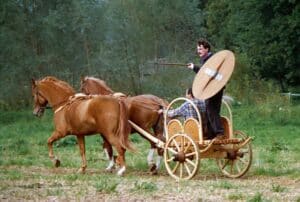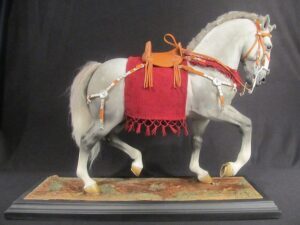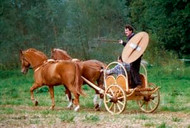Celtic Chariots & Cavalry
Posted by Charles MacGregor on Mar 9th 2019
Originally Published February 2013. Written for The Celtic Croft by Charles MacGregor of MacGregor Historic Games.
Celtic Chariots & Cavalry
As with many ancient peoples chariots were an important part of Celtic warfare. Chariots have been found among grave goods from La Tene era burials in Gaul to Yorkshire in Britain and appear on coins from the period. These were primarily light, single axle vehicles drawn by two ponies and carrying a single warrior and a driver.
In the words of Caesar:
"In chariot fighting the Britons begin by driving all over the field hurling javelins, and generally the terror inspired by the horses and the noise of the wheels are sufficient to throw their opponents' ranks into disorder. Then after making their way between the squadrons of their own cavalry, they jump down from the chariots and engage on foot. In the meantime their charioteers retire a short distance from the battle and place the chariots in such a position that their masters, if hard pressed by numbers, have an easy means of retreat to their own lines. Thus they combine the mobility of cavalry with the staying power of infantry; and by daily training and practice they attain such proficiency that even on a steep incline they are able to control the horses at a full gallop, and to check and turn them in a moment. They can run along the chariot pole, stand on the yoke, and get back into the chariot as quick as lightning."

Caesar's description from the first century B.C. shows that chariots were being used in Britain later than on the continent. The last recorded use of chariots in warfare on the continent was over a hundred years earlier at the Battle of Telemon in 225 B.C. Based on surviving tales they continued to be used for several centuries in Ireland. In spite of Caesar's description of javelin throwing, it seems that chariots were often used more as a means of fast transport on the battlefield than as fighting platforms.
"To each horseman were attached two servants, who were themselves skilled riders and, like their masters, had a horse. When the Galatian horsemen were engaged, the servants remained behind the ranks and proved useful in the following way. Should a horseman or his horse fall, the slave brought him a horse to mount; if the riders was killed, the slave mounted the horse in his master's place; if both were killed, there was a mounted man ready. When a rider was wounded, one slave brought back to camp the wounded man, while the other took his vacant place in the ranks." -Pausanius describing an attack on Greece in the second century.

Mounted horseman also fought alongside chariots, and by the late Iron Age, cavalry began to supplant the chariot on the battlefields especially among the Gauls and Iberian Celts. Historians have claimed in the past that cavalry was not that effective in battle until the invention of the stirrup provided a rider with more stability. However, more recently, it has been shown that a saddle with four pommels had been developed in Asia and had made it's way into Europe by the late Iron Age. The front pommels would extend out over the rider's legs and allow him to squeeze them between his thighs for a secure seat and to fight with a lance or sword. It has been suggested that it was the introduction of this type of saddle along with larger breeds of horses more suitable for riding may have been part of what brought about the decline of the chariot.

